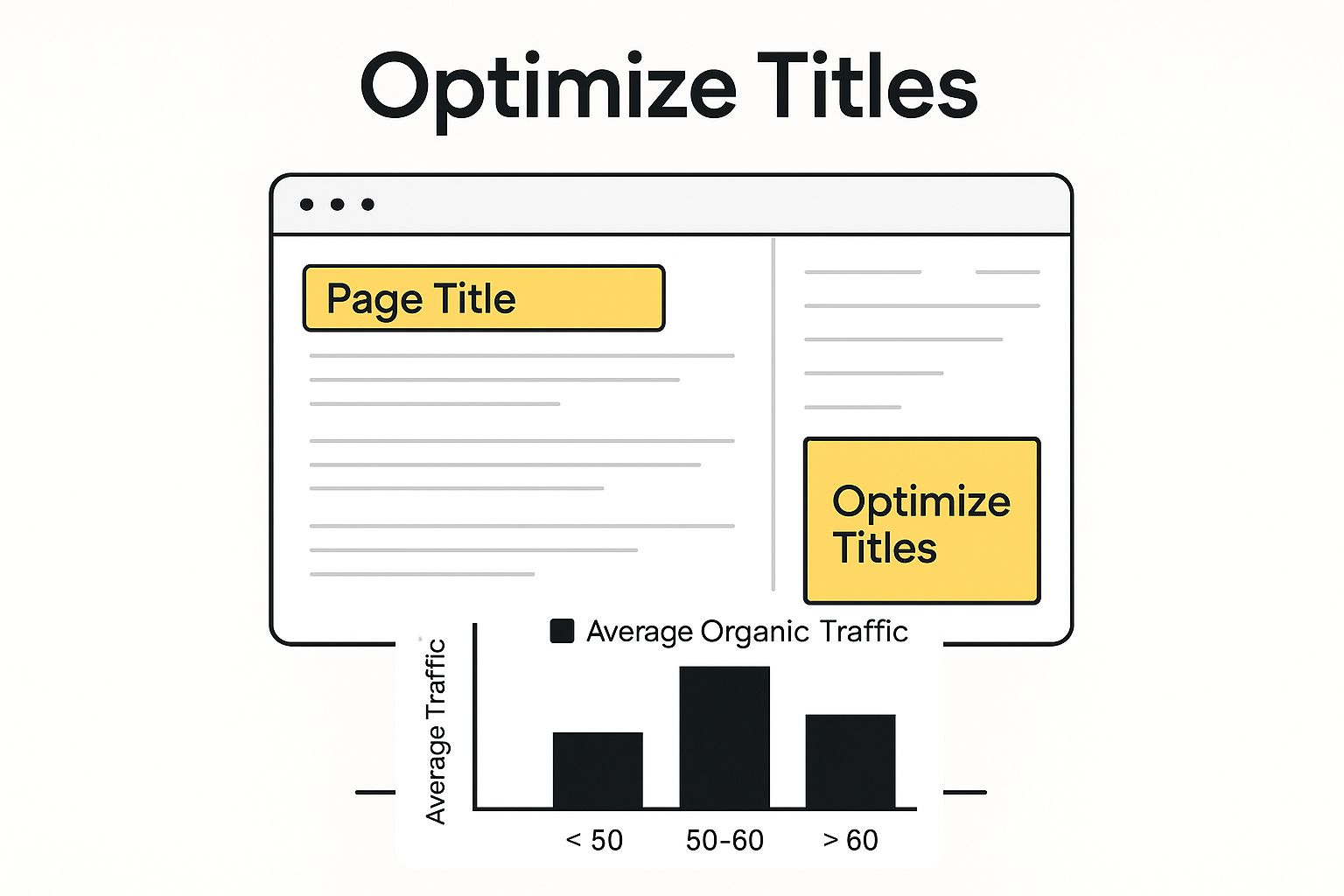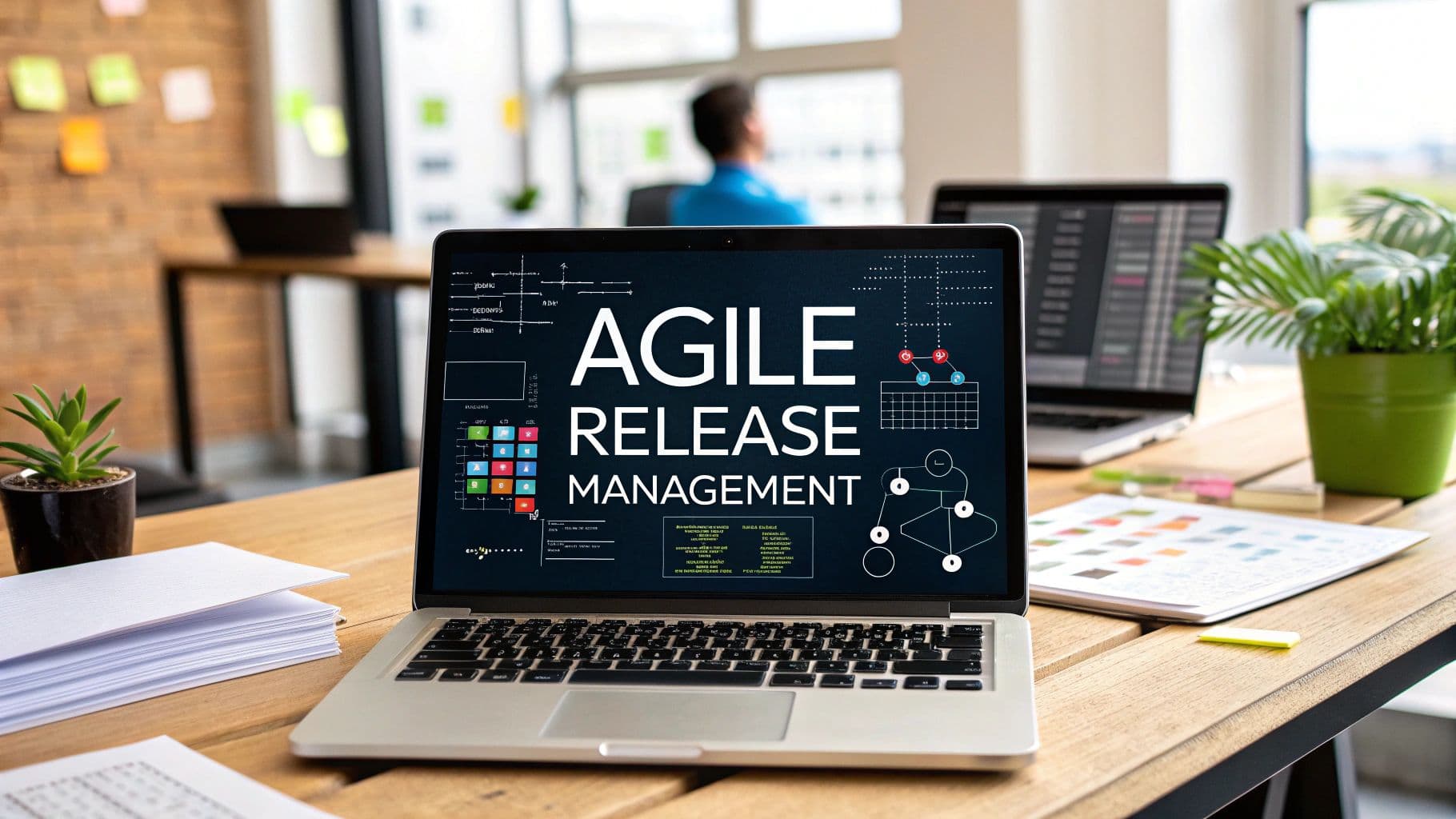static website SEO
technical optimization
organic traffic
link building
SEO analytics
Seo for Static Websites: Boost Your Search Rankings Fast
Why Static Websites Excel at SEO (When Done Right)
Static websites are making a comeback. While some might view them as outdated, businesses focused on speed and security are rediscovering their power. When optimized correctly, static websites offer unique SEO benefits that can significantly boost search rankings. These advantages aren't just theoretical; they lead to real improvements in online visibility and traffic. In fact, 71% of small businesses that invest in SEO see improvements in their online presence and traffic. Want to learn more? Find more detailed statistics here.
Speed and Performance: A Core Advantage
A major reason static websites excel at SEO is their inherent speed. Since the content is pre-built, the server doesn't have to generate pages dynamically each time someone visits. This results in much faster page load times, a key factor for search engine rankings. Imagine two restaurants: one pre-cooks meals (static), the other cooks to order (dynamic). The pre-cooked meal arrives much faster. Similarly, static web pages load quickly, improving user experience and boosting search rankings. This speed advantage is even more crucial in today's mobile-first indexing environment.
Enhanced Security: A Trust Signal
Static websites also shine when it comes to security. Their simpler architecture means fewer vulnerabilities compared to dynamic sites that use databases and server-side scripting like PHP. This inherent security reduces the risk of hacking and malware, building trust with both users and search engines. For instance, static sites are less prone to SQL injection attacks, a common vulnerability in dynamic sites. This added security acts as a strong trust signal, positively impacting search rankings.
Optimized Content: The Foundation of Static Site SEO
While static websites have built-in advantages, content optimization is still essential. This means using SEO best practices like keyword research and on-page optimization. The nature of static websites allows for careful fine-tuning of every element, from title tags and meta descriptions to content structure and internal linking. This control lets site owners craft highly optimized content that resonates with both search engines and users, ensuring each page contributes to the overall SEO strategy.
Strategic Link Building: Amplifying Your Authority
Finally, no SEO strategy is complete without link building. For static websites, earning high-quality backlinks is crucial. These backlinks are like endorsements from other websites, telling search engines your content is valuable and authoritative. By focusing on links from reputable sources, static websites can significantly improve their domain authority and search visibility. This can be achieved through various strategies, including content marketing, guest posting, and outreach to relevant websites. This strategic approach to link building is essential for long-term SEO success for any static website.
Technical Optimization That Actually Moves the Needle
Static websites are inherently fast and secure, offering a strong SEO foundation. But maximizing search ranking success requires going beyond these basics with technical fine-tuning specific to static site architecture.
Mastering Core Web Vitals
Core Web Vitals, such as Largest Contentful Paint (LCP) and Cumulative Layout Shift (CLS), are critical SEO metrics. Static sites, given their pre-built nature, have a head start in achieving top scores.
For instance, minimizing CLS is about optimizing image loading and preventing unnecessary layout shifts. This is simpler to manage within a static environment. A well-optimized site will load quickly and provide a smooth, seamless user experience.
Structured Data and XML Sitemaps
Structured data, through schema markup, allows search engines to interpret content more effectively, potentially enhancing visibility with rich snippets in search results. This provides valuable context to search engines, leading to more accurate and relevant search results.
An efficient XML sitemap guides search engines through your website's structure, ensuring comprehensive discovery and indexing of all pages. This is especially important for larger static sites with numerous pages.
The infographic below demonstrates how optimized titles within your static website’s CMS editor improve SEO.  A clear title allows search engines to understand page content quickly, directly impacting ranking potential. You might be interested in how to master SaaS boilerplates.
A clear title allows search engines to understand page content quickly, directly impacting ranking potential. You might be interested in how to master SaaS boilerplates.
Leveraging Browser Caching and Critical CSS
Browser caching prompts browsers to store static assets, resulting in faster load times for returning visitors. This improves user experience and can positively influence search rankings.
Employing a critical CSS path, prioritizing above-the-fold content styles, dramatically improves perceived load time. These optimizations have a significant positive effect on Core Web Vitals and SEO.
Optimizing Internal Linking and Canonical Tags
A robust internal linking strategy distributes link equity across your site, enhancing key page visibility. This helps search engines understand the relationships between pages and their relative importance.
Canonical tags address duplicate content issues, a potential concern even for static sites, particularly when content is syndicated or appears on multiple domains. This ensures that the correct version of a page is indexed, avoiding confusion for search engines.
One powerful SEO motivator, especially for static websites, is return on investment (ROI). Projections suggest an average SEO ROI of 748% in 2025. See further statistics here. This highlights SEO's effectiveness as a marketing strategy. By addressing these technical elements strategically, you position your static website for higher rankings and increased organic traffic.
To help you implement these strategies, we've provided a checklist below.
A Technical SEO Checklist for Static Websites: A comprehensive checklist of technical optimization factors specifically for static websites, with priority levels and impact ratings.
| SEO Element | Implementation Difficulty | SEO Impact | Priority Level |
|---|---|---|---|
| Optimize Images | Easy | High | High |
| Implement HTTPS | Easy | High | High |
| Create an XML Sitemap | Easy | High | High |
| Implement Structured Data | Medium | High | High |
| Minify HTML, CSS, and JavaScript | Medium | Medium | High |
| Leverage Browser Caching | Medium | Medium | Medium |
| Optimize Internal Linking | Medium | High | High |
| Implement Critical CSS | Medium | High | Medium |
| Use Canonical Tags | Medium | Medium | Medium |
| Optimize Page Speed | Hard | High | High |
This checklist provides a starting point for optimizing your static website. By focusing on the high-priority elements, you can make significant improvements to your site's SEO performance. Remember, consistent effort in technical SEO is key to long-term success.
Content That Ranks (Without Constant Updates)
Creating engaging content that consistently ranks well without needing constant updates is the holy grail of SEO for static websites. It's about understanding how to build a foundation of content that remains relevant and valuable over the long haul.
Keyword Research for Long-Term Success
Effective SEO starts with keyword research, but for static sites, the focus should be on evergreen keywords. These keywords relate to topics that remain consistently popular over time, unlike fleeting trends. Think "how to bake a cake" versus "unicorn cake decorating trends of 2024". By targeting keywords with sustained search volume, your content attracts organic traffic for months or even years to come.
Creating Content Clusters That Establish Authority
Topical authority is a key ranking factor. One of the best ways to build authority is through content clusters. A content cluster revolves around a central pillar page that covers a broad topic. This pillar page is then supported by cluster pages that delve into specific subtopics. This interlinked structure not only provides comprehensive information for users but also signals expertise to search engines like Google.
Balancing SEO and Engaging Writing
While SEO best practices are essential, remember that you're writing for humans, not just algorithms. Content should be informative, well-written, and provide genuine value. Think of it this way: SEO is the foundation of a house, but engaging writing is what makes it a home. Incorporate keywords naturally, but prioritize clarity and readability for a positive user experience. For inspiration on crafting engaging content, check out these resources on Next.js landing page templates.
Internal Linking and Content Freshness
Internal linking is crucial for SEO on static websites. It helps distribute link equity, improves site navigation, and reinforces topical connections between pages. Keep your content fresh by periodically updating existing articles with new data, examples, or recent developments. Adding a new section or refreshing statistics can boost relevance without requiring a complete website rebuild. These updates signal ongoing value to both users and search engines.
Real-World Examples of Evergreen Content Success
Many static websites successfully leverage evergreen content to achieve and maintain high search rankings. Sites providing in-depth tutorials, comprehensive guides, or resources on timeless topics often see consistent traffic over extended periods. This demonstrates the power of a strategic, evergreen content approach for long-term SEO success on static websites.
Building Domain Authority Through Strategic Links

For static websites, high-quality backlinks are the cornerstone of top search engine rankings. They are the difference between being buried in search results and achieving online visibility. This section explores proven link acquisition tactics that deliver results in competitive online spaces.
Identifying High-Value Link Opportunities
Finding high-value link opportunities is the first critical step. Analyzing your competitors' backlink profiles can uncover valuable link sources within your niche. For example, if a competitor has a link from a respected industry blog, this might be a potential link opportunity for your site. This type of competitive research provides a valuable guide for your own link-building activities.
Also, consider exploring online communities, forums, and industry directories relevant to your target audience. These platforms often provide link placement opportunities, boosting your overall SEO strategy.
Creating Linkable Assets for Static Websites
Static websites often face the hurdle of limited content updates. Creating linkable assets, however, can naturally attract backlinks.
- In-depth Guides and Tutorials: Offer comprehensive information that other sites will want to reference.
- Original Research and Data: Unique data and insights can attract attention from journalists and bloggers.
- Tools and Resources: Providing free, helpful tools relevant to your industry can draw links and generate interest.
These assets become go-to resources within your niche, attracting backlinks and driving traffic to your website.
Effective Outreach Strategies
Developing strong outreach strategies is essential for acquiring links. Personalize your outreach messages to highlight the value your content provides to the target website's audience. If you've developed a comprehensive guide, for example, explain how it complements the target website's existing content.
Using existing relationships can also unlock link opportunities. Connect with colleagues, industry contacts, and past collaborators to explore possible link placements or content partnerships. Strategically distributing link equity across your static pages ensures that your most important content benefits most, maximizing your SEO efforts.
Leveraging Content Partnerships and Expert Contributions
Successful static websites often gain authoritative backlinks through content partnerships and expert contributions. Collaborating with complementary businesses or influencers to create co-branded content can expand your reach and attract high-quality backlinks.
Contributing guest posts to relevant industry blogs can position you as an authority while also providing valuable links back to your website. This collaborative approach creates a diverse backlink profile, significantly improving your website’s overall SEO. Combining these link-building tactics will effectively build domain authority and achieve lasting high rankings for your static site.
Measuring What Matters: Analytics for Static Sites
Without proper measurement, your SEO efforts for static websites are just educated guesses. This section reveals how successful static website owners implement robust analytics, despite the perceived limitations of this architecture.
Setting Up Google Analytics and Search Console
The foundation of any effective SEO strategy is data. For that, you need Google Analytics and Google Search Console. While implementation might seem tricky for static websites, it's simpler than you think. Both platforms offer straightforward integration methods, regardless of your static site generator.
For Google Analytics, you'll typically add a tracking code snippet directly to your site's HTML, usually within the <head> section of each page. This code allows Google Analytics to collect data on user behavior, providing insights into how visitors interact with your content. You can then track metrics such as page views, bounce rate, and session duration.
Google Analytics requires verifying site ownership, usually by adding a DNS record or uploading an HTML file to your site’s root directory. Google Search Console gives you access to crucial data on keyword rankings, crawl errors, and site performance in Google search results. These tools help identify areas for optimization and track your site’s health and visibility.
Key Metrics for Static Websites
Understanding which metrics reflect SEO progress for static sites is essential. While page views and bounce rate provide general engagement insights, other factors are more specific to static site SEO success.
-
Crawl Errors: Monitoring crawl errors in Google Search Console alerts you to potential indexing issues. This data helps identify roadblocks preventing search engines from accessing your content.
-
Core Web Vitals: Strong Core Web Vitals are crucial. Tracking these metrics ensures your static site delivers the fast, smooth user experience that search engines reward.
-
Keyword Rankings: Consistent tracking reveals the effectiveness of your SEO efforts. You’ll see which keywords drive traffic and where improvement opportunities exist.
To help you organize these important metrics, take a look at the table below:
Tracking these Key Performance Indicators (KPIs) is essential for understanding your static website's SEO performance. The following table provides a breakdown of the most important metrics to monitor:
| KPI Category | Metric | Importance | Measurement Frequency | Target Benchmark |
|---|---|---|---|---|
| Technical SEO | Crawl Errors | High | Weekly | 0 |
| User Experience | Core Web Vitals | High | Monthly | Good (or above) |
| Visibility | Keyword Rankings | High | Weekly | Top 10 positions for target keywords |
This table summarizes the KPIs you should be focusing on, how often they should be measured, and what you should be aiming for. Regular monitoring and analysis of these KPIs will give you a clear picture of your SEO performance and identify areas needing attention.
Building Custom Dashboards and Tracking User Engagement
For a comprehensive view of your site's performance, build custom dashboards. These consolidate key SEO data from various sources, providing actionable insights. This tailored view allows you to track key metrics, identify trends and adjust your SEO strategy accordingly.
Tracking user engagement beyond basic page views can uncover deeper insights.
-
Consider implementing event tracking for interactions like file downloads, video views, or newsletter sign-ups.
-
For static sites, such detailed tracking reveals which content resonates best with your audience. This allows you to optimize existing content and create new content tailored to your audience’s preferences.
These advanced strategies, implemented with a clear focus on your business goals, are key for data-driven SEO success.
Testing SEO Changes and Identifying Technical Issues
Use analytics to identify technical issues before they significantly impact your rankings. For example, a sudden drop in organic traffic might indicate a crawling issue. Consistent monitoring can also highlight issues with Core Web Vitals or reveal declining keyword rankings.
While complex A/B testing platforms may not be feasible for all static sites, simpler methods exist. Analyze performance changes after SEO updates, tracking keyword movement and traffic patterns. This helps pinpoint successful strategies and identify areas for refinement. This data-driven approach ensures your SEO changes are effective and your static site remains optimized.
Choosing The Right Static Site Generator For SEO
Not all static site generators are created equal when it comes to SEO. Picking the right one is essential for your static website's search performance. This means carefully considering factors like metadata control, structured data implementation, and image optimization.
Key SEO Features To Consider
When evaluating static site generators for SEO, look for these key features:
-
Metadata Control: Make sure the generator allows easy customization of title tags, meta descriptions, and other important meta tags. This is crucial for on-page optimization and telling search engines what your content is about.
-
Structured Data Implementation: Look for generators that simplify adding schema markup for rich snippets. This helps search engines better understand your content, potentially boosting visibility in search results. Schema markup provides context to your content.
-
Image Optimization: Image optimization is critical for site speed. Choose a generator that supports features like image compression and lazy loading to improve page load times and Core Web Vitals. A fast-loading site provides a better user experience.
Comparing Popular Static Site Generators
Let's compare some popular options and their SEO capabilities:
| Static Site Generator | Metadata Control | Structured Data | Image Optimization | SEO Plugins |
|---|---|---|---|---|
| Jekyll | Excellent | Good | Good | Moderate |
| Hugo | Excellent | Good | Good | Moderate |
| Gatsby | Excellent | Excellent | Excellent | Extensive |
| Eleventy | Excellent | Good | Good | Growing |
Each generator offers a different balance of features and complexity. Jekyll and Hugo are known for simplicity and speed, while Gatsby excels in performance and has a rich plugin ecosystem. Eleventy is gaining popularity for its flexibility and modern approach. You might be interested in: Learn more about SEO and Next.js in our guide.
Hidden Configuration Options and Plugins
Many static site generators have hidden configuration options that can significantly impact SEO. For example, some generators let you customize the robots.txt file and XML sitemap generation directly within the configuration file. Explore these options to fine-tune your site's SEO settings. Properly configured robots.txt and sitemaps are essential for search engine crawlers.
Additionally, plugins can enhance SEO capabilities. For example, some plugins automate image optimization or simplify structured data implementation. Plugins can save you time and improve your site's technical SEO.
Real-World SEO Success and Migration Strategies
Many successful websites use static site generators and achieve top rankings. Analyze these examples to understand how different generators are used in the real world. Seeing successful implementations can inspire your own SEO strategy.

If your current generator is limiting your SEO potential, consider migrating to a more SEO-friendly platform. Carefully plan your migration strategy to minimize disruptions and maintain existing SEO value. This includes redirecting old URLs to new ones and ensuring proper metadata transfer. A smooth migration is key to preserving your search rankings. Choosing the right generator and optimizing its settings are crucial steps in achieving strong SEO results for your static website.
Future-Proofing Your Static Site for Algorithm Changes
Search engine algorithms are constantly changing. However, static websites, with their inherent speed and stability, are well-suited to adapt. By understanding emerging trends and focusing on core SEO principles, you can ensure your static site remains competitive.
Preparing for Voice and Visual Search
Voice search and visual search are transforming how users interact with search engines. This presents both challenges and opportunities for static websites. Optimizing for voice search involves focusing on long-tail keywords and conversational content, much like an evergreen content strategy. This means structuring content around questions users are likely to ask out loud.
Visual search, on the other hand, relies heavily on image optimization and structured data. Static site generators often excel at image optimization, giving you a distinct advantage. Implementing structured data for images helps search engines like Google understand the context of your visuals, enabling them to appear in relevant image searches.
Adapting to AI-Driven Ranking Factors
AI-driven ranking factors are becoming increasingly important. While the exact algorithms remain unclear, focusing on user experience is paramount. A core strength of static sites is their ability to deliver fast load times. This natural advantage aligns perfectly with the emphasis on Core Web Vitals.
Structuring content logically with clear headings and semantic HTML benefits both users and AI algorithms. This clear structure contributes to a positive user experience and improves accessibility.
Maintaining SEO for Static Websites Over Time
Ongoing SEO maintenance for static websites doesn't have to be difficult. By building a solid foundation and focusing on sustainable strategies, you can minimize future effort.
Here are some key areas for long-term SEO maintenance:
- Regular Content Audits: Periodically review existing content for relevance and identify opportunities for updates.
- Backlink Monitoring: Track your backlinks to ensure they remain high-quality and relevant. Address any broken or low-value links promptly.
- Technical SEO Checks: Regularly audit your site for technical issues, such as broken links, crawl errors, and outdated metadata.
- Algorithm Updates: Stay informed about major search engine algorithm changes and adapt your strategies as needed.
Maintaining Competitive Rankings
Maintaining high rankings requires continuous effort, even for static websites. Focusing on fundamental SEO best practices and adapting to user behavior ensures long-term visibility.
Staying ahead of the curve can feel challenging. However, focusing on core principles and adapting to user needs ensures your static site not only survives algorithm updates, but thrives. This proactive approach is far more effective than simply reacting to every algorithm tweak. Staying informed about emerging technologies and user behaviors will allow you to anticipate future changes and adapt accordingly.
Want to build a future-proof website with the speed and security of a static site? Check out AnotherWrapper, an AI starter kit built with Next.js. Launch your micro SaaS project quickly. Learn more at AnotherWrapper.com.
Fekri




